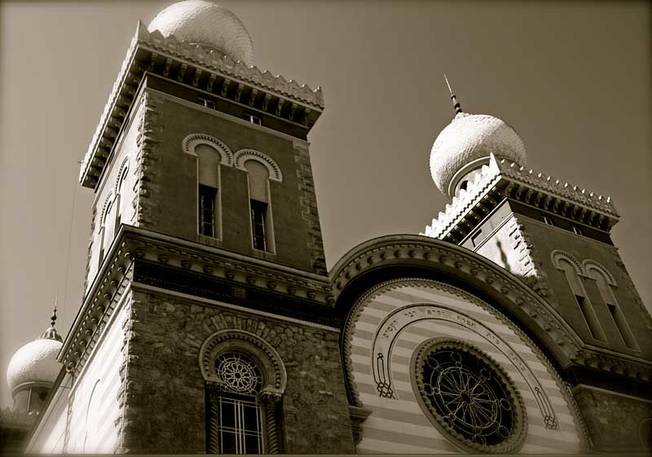


On December 8 the auditorium of the Center for Jewish History [2] hosted the last event organized by the Primo Levi Center of New York for the Autumn Season. Again, the protagonist was the Region of Piedmont and its centenary Jewish community [3]. The event “Unfolding Borders: the Jews of Piedmont”, divided in three different sections, was attended by a considerable number of people who found in it an important occasion to learn more about that land’s history, beauty, and landmarks.
The speaker of the first section was Jacob Wisse, director of the Yeshiva University Museum. [4] "I am very proud to be here as the representative of a museum dedicated to the preservation and reinterpretation of the Jewish culture from a historical point of view. The art and culture of the Jews of Piedmont is distinct and really specific, and also part of a broader history that relates to the tradition of our people within the context of Italy".
Mr. Wisse thoroughly retraced the history of the Jewish community in Piedmont starting from the time they first arrived in the area in the 14th century up to these days. He explained to the audience that the group, that barely reaches 50.000 members by now, is considered with special interest by the scholarly world since it still today preserves its traditions and culture in spite of the current processes of globalization.
The second section featured the screening of the documentary “Il Ritorno” (The Return) produced in 1980 by Giorgio Treves with the participation of Uto Ughi. Winner of the ASOLO Prize at the International Festival of Art in Asolo. The 42 minute film took the audience on a journey across the main Jewish landmarks of Piedmont, revisited through the stories and testimonials of the members of the local community. The plot of the picture, indeed, was based on the return home of a violinist, interpreted by the Italian legend Uto Ughi [5], who accompanied his visits to the decaying synagogues of the region with music by Bach and Mozart. The result was a touching voyage to places of which there is no relevant historical memory yet, but which hide unsuspected beauties and testify to the humanistic spirit of the Italian Jewish tradition which the region of Piedmont is willing to promote and spread.
The documentary was also an occasion for Director Indrimi to thank the Cahnman Foundation [6] on behalf of all those present. The foundation, founded in memory of Gisella Levi Cahnman, has not only sponsored the Center’s public programs during the last few years, but is also contributing to the restoration of some of Piedmont’s synagogues.
The second speaker of the evening, Professor Giorgio Sacerdoti, president of CDEC [7] (Centro per la Documentazione Ebraica Contemporanea - Center for Contemporary Jewish Documentation) followed the same path as the documentary. With the help of slideshows and multimedia contents, he followed the lives and experiences of a group of Jewish families that emigrated from Piedmont to America between the 15th and the 20th century. His lecture "From the Ghetto to America: Five Piedmontese Families in Motion" thus became a peculiar and original point of view to look at the diaspora of a people and how it evolved in the last centuries, its meanings, its consequences.
The third and last part of the evening, finally, consisted in the screening of the video "Rav Dario Disegni, a 20th-Century Story", produced in collaboration with the Archivio Terracini of Turin. It presented the virtual exhibition dedicated to Rabi Disegni, the spiritual guide of the Jewish Community of Turin from 1935 to 1959, that was organized by the city of Turin between the end of 2008 and early 2009. Set against the larger historical context that goes from the Unification of Italy to the end of World War II, the display analyzed five different moments of Rabbi Disegni's life: his education in the early XX century; his spiritual growth within the Jewish community of the time; the two world wars; his religious activity of spreading and teaching the Jewish tradition; the translation of the Bible, to which he dedicated the last period of his life.
Those attending the event certainly left the auditorium with a greater knowledge about the Jewish community of Piedmont, and the desire to visit those areas and monuments that appeared so magnificent in video. The books that were presented during the evening could with no doubt provide a good source of information for those willing to know more about the history and culture of the people who have lived and still populate the area. The first, Ebrei Piemontesi. The Jews of Piedmont. (Yeshiva University Museum, 2008), a collection of nice essays and rare illustrations, was published in conjunction with a Yeshiva University Museum exhibition and is available only in English.
The second, The Synagogues of Piedmont. Words, Images, Objects and Architecture. (Franco Lattes, Paola Valentini, Umberto Allemandi Publishing House [8], 2009) is the result of a collaboration of the Jewish Community of Turin and the publishing house Umberto Allemandi. Published both in Italian and English, it offers an insight on Jewish contemporary life in Piedmont and the artistic and intellectual heritage that enriches it.
A Twentieth Century Story: Rabbi Dario Disegni (1878-1967)
Source URL: http://440468.6bgr9ubv.asia/magazine/focus/life-people/article/insight-jewish-community-piedmont
Links
[1] http://440468.6bgr9ubv.asia/files/sinagoga-torino21262208268jpg
[2] http://www.cjh.org
[3] http://www.torinoebraica.it/
[4] http://www.yu.edu/museum
[5] http://www.utoughi.com
[6] http://www.ajsnet.org/cahnman.html
[7] http://www.cdec.it
[8] http://www.allemandi.com
[9] http://www.primolevicenter.org